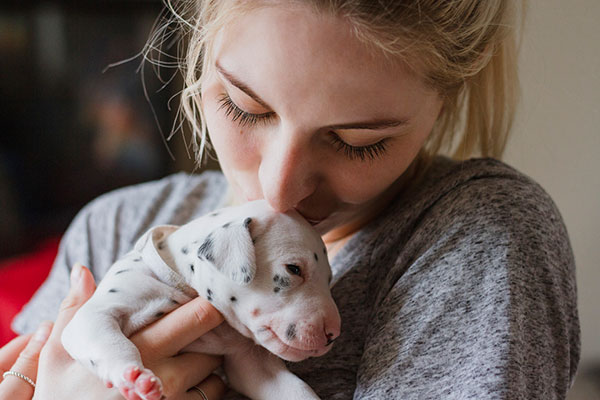Stockwatch: nation of pet lovers needed to keep this share healthy
12th October 2021 10:21
by Edmond Jackson from interactive investor
A justified high rating, or another sign of too much cash chasing growth stocks? Here’s what our companies analyst thinks about this AIM stock.

Could you have imagined a UK vets group approaching £2 billion in market value?
CVS Group (LSE:CVSG) has seen its stock soar from around 800p in March 2020 to a recent high of £27.70. This was reached after the 23 September results for the year to 30 June, since when it has eased to £24.00.
That price puts the shares on 32x normalised earnings per share (EPS) of 75p based on £19.3 million net profit achieved. Market value is 3.3x sales and the operating margin just shy of 8%.
In fairness, CVS beat expectations for EPS of 69.7p and consensus has upgraded from 77.9p to 79.5p in respect of the June 2022 year. If that rises to 85.4p based on £61.7 million profit in 2023, the price/earnings (PE) ratio eases from 30x to 28x.
Is this really justified for veterinary services, or is mean reversion inevitable at some point?
Are some UK growth stocks now a parallel with the US?
Coincidentally, US analyst Michael Lebowitz has shown the “Buffett indicator” of stock market capitalisation to GDP passing its 2000 tech bubble peak. PE multiples are also stretched, to three standard deviations above the 10-year average, which matches or exceeds seven other peaks in the last 100 years.
On such a benchmark, the upside for equities is limited and, if PE values mean-revert, we should expect 36% losses. That could extend to 50% given the propensity of markets to over-shoot, unless the “wall of money” argument prevails.
My concern is inflation being liable to push up interest rates, meaning a cooler climate than the hot-house for stocks, created by enormous monetary stimulus (QE and ultra-low rates) since March 2020.
A potential exception for CVS however is a free cash flow profile consistently stronger than EPS (see table below) hence a forward cash flow multiple nearer 20x.
15% increase in cats and dogs alone since Covid
The stock took off from March 2020, I believe due to monetary stimulus coinciding with exceptional demand for pets. An estimated 3.2 million households acquired a cat or dog since lockdowns began, taking the total number of such animals alone to 24 million in the UK.
With average lifespans of a decade, that implies more high-quality revenue for CVS – funded chiefly by insurance plans. It is a substantive operation with 506 practices, eight specialist referral hospitals and 34 dedicated out-of-hours sites.
I would expect that a fair portion of impulsively acquired pets are already being re-homed, thereby tempering demand from those who might have considered buying from a breeder. With living costs now soaring, dog ownership especially may test what people can afford.
It is therefore possible that “24 million UK cats and dogs” represents a medium-term peak, yet the market is pricing CVS for strong growth persisting. That would need to involve margin expansion if the number of UK pets consolidates.
Historical record assisted by acquisitions
The six-year table does show strong annual revenue growth - around 25% pre-Covid – but is not purely organic growth.
This raises risk (which growth ratings have come to ignore) as shown by a decline in profits/earnings from 2017 to 2019 when some acquisitions failed to meet hopes. It’s why the stock fell from over £14 to near 430p during this time.
- Have you examined our award-winning stocks and shares ISA?
- Don't be shy, ask ii...how do I tidy up my investment portfolio?
Vets practices have offered scope for industry consolidation, especially as retiring owners of practices have lacked successors, but this will reach limits, hence at some point attention will focus on like-for-like performance.
A 17% rise in like-for-like revenue to £510 million benefited from a favourable comparator - sub-1% in the June 2020 year when its fourth quarter was compromised by the UK’s first Covid lockdown. Total revenue grew just over 19% due to nine “synergistic” acquisitions made during the financial year.
Like-for-like revenue up 14% in the new financial year
Current growth is well ahead of 4% we saw this time last year, which later improved to 17% for the financial year as a whole. Total sales are up nearly 18% against 4% last time.
This has been helped by a further price increase last July, additional to a delayed price increase last January. Yes, insurance policies will absorb this in the short run, but in the longer-term premiums must rise thereby adding to pets’ cost.
An annual pay increase was brought forward to 1 July, a sign of the need to retain staff amid industry skills shortages.
One industry report last July cited the UK profession in crisis: there are more vets graduating but the number is insufficient to meet all the extra animals, and there has been an element of EU vets returning home.
I am still inclined to target a longer-term underlying growth rate nearer 10%, implying mean-reversion of the stock rating.

More acquisitions?
After a few years into a marketing roll-out or industry consolidation by a publicly held company, its board should justify what scope remains for further acquisitions. Otherwise, if the stock has achieved a high rating, traders may be playing a game of pass-the-parcel.
The chairman’s statement refers simply to being “well placed to integrate future acquisitions successfully, should opportunities arise”.
Gearing is described as having reduced from 1.1x to below 0.7x, despite a 15% reduction in cash generated from operations to £80 million – albeit due to deferred taxation than anything business-specific.
Looking at the end-June balance sheet, it had £84 million (all) long-term debt relative to £34 million cash and £191 million net assets, implying “gearing” includes £99 million lease liabilities. In this case, net debt was around £149 million or gearing nearer 0.8x (or 80%).
Gearing up moderately has made sense while long-term interest rates have remained low. Yet CVS’s numbers for return on capital employed – also equity – have only recently reached double-digit percentages.
A £7 million annual interest charge was covered 5.7x by operating profit and the cash flow statement shows a £12 million rise in group cash for the year.
CVS Group - financial summary
Year end 30 Jun
| 2015 | 2016 | 2017 | 2018 | 2019 | 2020 | 2021 | |
| Revenue (£ million) | 167 | 218 | 272 | 327 | 407 | 428 | 510 |
| Operating margin (%) | 5.9 | 5.4 | 6.3 | 5.4 | 3.8 | 4.3 | 7.9 |
| Operating profit (£m) | 9.8 | 11.8 | 17.2 | 17.7 | 15.6 | 18.5 | 40.1 |
| Net profit (£m) | 6.8 | 7.0 | 11.5 | 10.7 | 8.2 | 5.7 | 19.3 |
| Reported EPS (p) | 11.6 | 11.4 | 18.2 | 16.0 | 11.6 | 8.1 | 27.3 |
| Normalised EPS (p) | 11.6 | 12.3 | 18.2 | 15.4 | 11.9 | 12.5 | 27.3 |
| Price/earnings ratio (x) | 87.9 | ||||||
| Operating cashflow/share (p) | 31.6 | 45.6 | 47.1 | 56.0 | 58.6 | 110 | 85.2 |
| Capital expenditure/share (p) | 11.1 | 18.8 | 21.9 | 16.0 | 18.3 | 17.6 | 23.5 |
| Free cashflow/share (p) | 20.6 | 26.8 | 25.2 | 40.0 | 40.4 | 92.3 | 61.7 |
| Dividend/share (p) | 3.0 | 3.5 | 4.5 | 5.0 | 5.5 | 0.0 | 6.5 |
| Yield (%) | 0.3 | ||||||
| Earnings cover (x) | 3.9 | 3.3 | 4.1 | 3.2 | 2.2 | 4.2 | |
| Cash (£m) | 3.0 | 6.7 | 6.8 | 15.0 | 12.5 | 21.5 | 33.7 |
| Net debt (£m) | 46.2 | 93.1 | 100 | 69.0 | 102 | 161 | 149 |
| Net asset value (£m) | 39.1 | 46.6 | 88.0 | 158 | 163 | 167 | 191 |
| Net asset value/share (p) | 66.0 | 77.7 | 138 | 224 | 231 | 236 | 270 |
Source: historic company REFS and company accounts
Resumption of ‘a progressive dividend policy’
Having grown to 5.5p a share in respect of the 2019 financial year, dividends were suspended due to CVS taking advantage of government support during the pandemic.
A 6.5p proposed final dividend therefore retains the sense of dividend growth, but even with consensus looking for over 8p in respect of the current financial year, it implies a negligible yield of 0.33%.
- Subscribe to the ii YouTube channel for interviews with popular investors
- Take control of your retirement planning with our award-winning, low-cost Self-Invested Personal Pension (SIPP)
In chart terms, the 13% drop from £27.70 puts the stock back on the trend-line. For the short to medium term, it does look as if CVS will continue to deliver good numbers relative to enough other industries, underwritten by insurance policies for all the new pets.
I see a consolidation as the more likely scenario, however, as a first interest rate rise tempers growth stock ratings. A slowdown in growth of the number of pets, partly because their costs (including insurance) will start to price some people out of ownership, will also moderate progression.
I would therefore avoid CVS with fresh money and, unless you refute my concerns, then lock in some gains. This is a sound underlying business but acquisitions – and hopes for them continuing – have put the stock on an unsustainable rating. Overall: Sell.
Edmond Jackson is a freelance contributor and not a direct employee of interactive investor.
These articles are provided for information purposes only. Occasionally, an opinion about whether to buy or sell a specific investment may be provided by third parties. The content is not intended to be a personal recommendation to buy or sell any financial instrument or product, or to adopt any investment strategy as it is not provided based on an assessment of your investing knowledge and experience, your financial situation or your investment objectives. The value of your investments, and the income derived from them, may go down as well as up. You may not get back all the money that you invest. The investments referred to in this article may not be suitable for all investors, and if in doubt, an investor should seek advice from a qualified investment adviser.
Full performance can be found on the company or index summary page on the interactive investor website. Simply click on the company's or index name highlighted in the article.